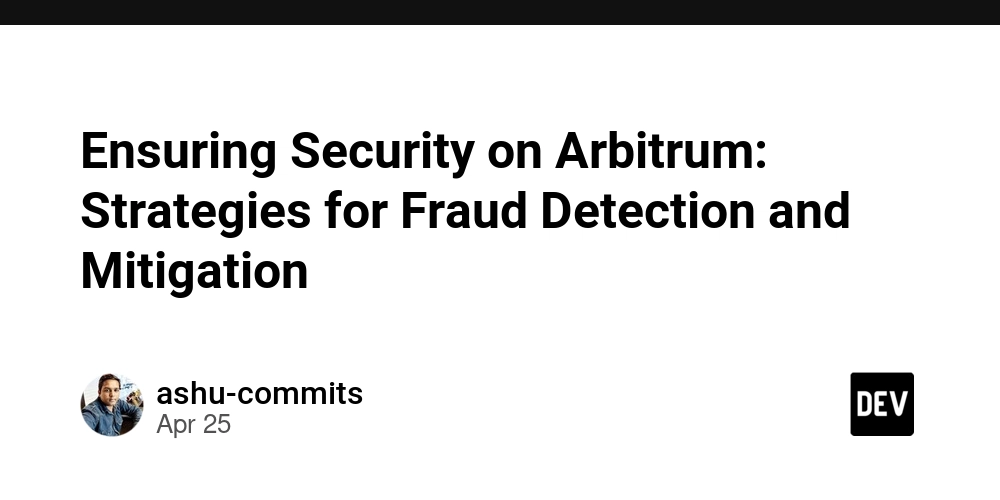Ensuring Security on Arbitrum: Strategies for Fraud Detection and Mitigation
Abstract: This post provides a comprehensive exploration of fraud detection and mitigation strategies on Arbitrum—a leading layer‑2 solution that leverages optimistic rollups for Ethereum scalability. In addition to a detailed look into the platform’s architecture and vulnerabilities, we cover smart contract audits, machine learning for anomaly detection, automated alert systems, and community-driven governance. Through structured tables, bullet lists, and relevant case studies, we discuss the technical and practical approaches that make Arbitrum more secure. We also draw insights from open-source funding trends and insights from industry experts. For an initial discussion on this subject, check out the original article on Arbitrum Fraud Detection. Introduction As blockchain technology evolves, scaling solutions like Arbitrum are becoming key players in addressing Ethereum’s challenges with speed and cost. However, the rapid expansion of blockchain ecosystems invites both innovation and new risks. Fraud detection and effective mitigation strategies are crucial to secure these networks. In this post, we dive into the architecture of Arbitrum, its potential vulnerabilities, and examine several robust approaches for mitigating fraud. Our discussion is technical yet accessible, designed to benefit developers, security experts, and blockchain enthusiasts alike. We'll also incorporate insights on machine learning, automated alert systems, enhanced governance, and community-based monitoring to bolster security. Background and Context Arbitrum is built on the basis of optimistic rollups, a scaling solution that processes transactions off-chain and later submits compressed proofs to Ethereum’s mainnet. For more technical details on this method, you can visit the Optimistic Rollups documentation on Ethereum. Historically, scalability has been a major challenge in the blockchain landscape. Ethereum's network congestion and high fees prompted developers to explore Layer‑2 solutions, such as Arbitrum, which not only enhance transaction throughput but also maintain decentralization principles. However, every innovative technology comes with its own set of potential vulnerabilities—ranging from validator collusion to smart contract exploits. Understanding these core issues forms the baseline from which to address fraud detection effectively. Key terms in this context include: Fraud detection: Techniques to identify and prevent unauthorized transactions or malicious behaviors. Validator collusion: Risk scenarios where multiple validators work together to manipulate transaction outcomes. Smart contract audits: Comprehensive reviews of code to ensure security, prevent bugs, and reduce exploit risk. Core Concepts and Features The main pillars that ensure security on Arbitrum involve a blend of technological and governance strategies. Below is a detailed breakdown of these core concepts. Enhanced Algorithmic Detection Arbitrum leverages advanced machine learning models to perform anomaly detection. This involves training algorithms to recognize patterns that deviate from expected transaction behaviors. For example, by analyzing network data, ML models can detect irregular peaks in transaction volume or sudden changes in validator behavior. Read more about these techniques in this machine learning in blockchain article. Automated Alert Systems Automated systems using real‑time monitoring ensure swift reaction times during suspicious activities. By incorporating threshold-based alerts, systems continuously evaluate transactions and instantly notify stakeholders upon detecting anomalies. Services like AWS’s real-time monitoring tools can be integrated for enhanced responsiveness. Multi-layered Security Protocols To combat risks like validator collusion and Sybil attacks, Arbitrum employs: Robust identity verification steps Decentralized consensus mechanisms These methods improve trust in the network and reduce the chances of coordinated attacks. For insights into how validator incentives work, refer to Arbitrum and Validator Rewards. Rigorous Smart Contract Audits One of the strongest defenses against vulnerabilities is conducting regular smart contract audits. During these audits, professionals review code for potential flaws using both manual reviews and automated formal verification tools. Organizations like Consensys Diligence provide expert smart contract reviews. This practice ensures that the contracts deployed on Arbitrum are secure and resilient. Community-driven Monitoring A vibrant blockchain community is indispensable. By encouraging bug bounty programs, users are incentivized to report issues. Programs facilitated through platforms such as HackerOne support this proactive approach. In addition, community-led governance platforms contribute to decisions that can enhance security protocols over t

Abstract:
This post provides a comprehensive exploration of fraud detection and mitigation strategies on Arbitrum—a leading layer‑2 solution that leverages optimistic rollups for Ethereum scalability. In addition to a detailed look into the platform’s architecture and vulnerabilities, we cover smart contract audits, machine learning for anomaly detection, automated alert systems, and community-driven governance. Through structured tables, bullet lists, and relevant case studies, we discuss the technical and practical approaches that make Arbitrum more secure. We also draw insights from open-source funding trends and insights from industry experts. For an initial discussion on this subject, check out the original article on Arbitrum Fraud Detection.
Introduction
As blockchain technology evolves, scaling solutions like Arbitrum are becoming key players in addressing Ethereum’s challenges with speed and cost. However, the rapid expansion of blockchain ecosystems invites both innovation and new risks. Fraud detection and effective mitigation strategies are crucial to secure these networks.
In this post, we dive into the architecture of Arbitrum, its potential vulnerabilities, and examine several robust approaches for mitigating fraud. Our discussion is technical yet accessible, designed to benefit developers, security experts, and blockchain enthusiasts alike. We'll also incorporate insights on machine learning, automated alert systems, enhanced governance, and community-based monitoring to bolster security.
Background and Context
Arbitrum is built on the basis of optimistic rollups, a scaling solution that processes transactions off-chain and later submits compressed proofs to Ethereum’s mainnet. For more technical details on this method, you can visit the Optimistic Rollups documentation on Ethereum.
Historically, scalability has been a major challenge in the blockchain landscape. Ethereum's network congestion and high fees prompted developers to explore Layer‑2 solutions, such as Arbitrum, which not only enhance transaction throughput but also maintain decentralization principles. However, every innovative technology comes with its own set of potential vulnerabilities—ranging from validator collusion to smart contract exploits. Understanding these core issues forms the baseline from which to address fraud detection effectively.
Key terms in this context include:
- Fraud detection: Techniques to identify and prevent unauthorized transactions or malicious behaviors.
- Validator collusion: Risk scenarios where multiple validators work together to manipulate transaction outcomes.
- Smart contract audits: Comprehensive reviews of code to ensure security, prevent bugs, and reduce exploit risk.
Core Concepts and Features
The main pillars that ensure security on Arbitrum involve a blend of technological and governance strategies. Below is a detailed breakdown of these core concepts.
Enhanced Algorithmic Detection
Arbitrum leverages advanced machine learning models to perform anomaly detection. This involves training algorithms to recognize patterns that deviate from expected transaction behaviors. For example, by analyzing network data, ML models can detect irregular peaks in transaction volume or sudden changes in validator behavior. Read more about these techniques in this machine learning in blockchain article.
Automated Alert Systems
Automated systems using real‑time monitoring ensure swift reaction times during suspicious activities. By incorporating threshold-based alerts, systems continuously evaluate transactions and instantly notify stakeholders upon detecting anomalies. Services like AWS’s real-time monitoring tools can be integrated for enhanced responsiveness.
Multi-layered Security Protocols
To combat risks like validator collusion and Sybil attacks, Arbitrum employs:
- Robust identity verification steps
- Decentralized consensus mechanisms
These methods improve trust in the network and reduce the chances of coordinated attacks. For insights into how validator incentives work, refer to Arbitrum and Validator Rewards.
Rigorous Smart Contract Audits
One of the strongest defenses against vulnerabilities is conducting regular smart contract audits. During these audits, professionals review code for potential flaws using both manual reviews and automated formal verification tools. Organizations like Consensys Diligence provide expert smart contract reviews. This practice ensures that the contracts deployed on Arbitrum are secure and resilient.
Community-driven Monitoring
A vibrant blockchain community is indispensable. By encouraging bug bounty programs, users are incentivized to report issues. Programs facilitated through platforms such as HackerOne support this proactive approach. In addition, community-led governance platforms contribute to decisions that can enhance security protocols over time. Learn more about this approach under Arbitrum and Community Governance.
Structured Security Strategies: A Comparative Table
Below is a table summarizing key fraud detection and mitigation strategies on Arbitrum:
| Strategy | Description | Benefit |
|---|---|---|
| Algorithmic Anomaly Detection | Uses machine learning models to detect unusual transaction patterns. | Early detection of potential fraud. |
| Automated Alert Systems | Real-time triggers based on preset thresholds to notify anomalies. | Immediate response to suspicious activities. |
| Multi-layered Security | Combines identity verification and decentralized consensus to prevent collusion. | Reduction in security breaches. |
| Smart Contract Audits | Regularly scheduled code reviews and formal verification by specialists. | Prevention of exploits and vulnerabilities. |
| Community Bug Bounties | Incentivizing the community to find and report vulnerabilities via bounty programs. | Enhanced network surveillance. |
Applications and Use Cases
Arbitrum’s fraud detection and mitigation methods have multiple practical applications within the blockchain ecosystem. Here are some notable examples:
1. Preventing Validator Collusion
In scenarios where validators might conspire to manipulate transaction order or firmware, the combined use of machine learning and multi-layer security protocols becomes crucial. For example, if abnormal validator activity is detected, automated systems can flag and halt transactions until further investigation is completed. By referencing security best practices in documents like Arbitrum Governance, stakeholders can enforce rollback measures to mitigate damage.
2. Securing NFT Marketplaces
As non-fungible tokens (NFTs) gain traction on platforms built on Arbitrum, securing smart contracts is paramount. NFT marketplaces depend on the integrity of smart contracts to ensure that ownership transfers and minting procedures are fraud-free. Thus, regular audits and community-driven governance combined with real‑time monitoring help maintain trust in these digital assets. This practice aligns with discussions in Smart Contracts on Blockchain.
3. Enabling DeFi Transactions
Decentralized finance (DeFi) applications on Arbitrum benefit from an automated alert system that monitors transaction validity. Any deviation from expected patterns triggers alerts and possibly automatic reversion of transactions. These capabilities provide a safety net against rapid exploits or flash loan attacks. More on these trends can be found in related articles covering Arbitrum and De-Fi Yield.
Challenges and Limitations
While Arbitrum’s advanced mitigation strategies significantly enhance security, there are persistent challenges and limitations that must be addressed:
- Validator Collusion: Even with decentralized consensus, the risk of coordinated validator behavior remains. Continuous algorithm updates and independent audits are essential.
- Smart Contract Complexity: As contracts grow more complex, the audit process becomes resource-intensive, potentially leaving gaps prior to detection.
- Automated Alert Overload: An abundance of false positives may lead to "alert fatigue," where genuine threats could be overlooked.
- Adoption and Integration: Integrating advanced security systems with existing protocols requires coordinated efforts across the community, developers, and regulators.
- Regulatory Changes: Changes in blockchain regulation may impose additional compliance burdens, which can delay updates or lead to new vulnerabilities.
A bullet list summarizing these challenges:
- Validator collusion and coordinated attacks
- Smart contract complexity and audit scalability
- False positive rates in automated systems
- Integration with existing platforms
- Regulatory and compliance issues
Future Outlook and Innovations
Looking forward, the security landscape of Arbitrum and similar layer‑2 solutions is expected to evolve. Some key trends include:
1. Improved Machine Learning Algorithms:
The next generation of anomaly detection models will leverage more data, refined techniques, and cross-chain analytics. This will lower the false positive rates and better capture subtle security anomalies.
2. Advanced Smart Contract Verification:
Innovations in formal verification and automated code analysis tools promise to enhance the precision of smart contract audits. This proactive approach could significantly reduce exploitable vulnerabilities.
3. Enhanced Community Governance:
Decentralized governance models are likely to become more robust. By utilizing blockchain voting and DAO (Decentralized Autonomous Organization) models, community members will increasingly influence security upgrades, ensuring that detection protocols are always aligned with current threats. For further insights on open-source governance, see the discussion on community-driven projects on Dev.to.
4. Cross-Chain Security Protocols:
As blockchain networks become increasingly interconnected, the need for cross-chain interoperability in fraud detection will drive new innovations. Efforts are already underway to adapt protocols across platforms, enhancing overall network security.
5. Increased Regulatory Clarity:
Improved regulatory environments in blockchain could lead to enhanced cooperation between public authorities and blockchain projects, driving the evolution of more comprehensive security standards.
Integrating Security with Open-Source Innovation
Arbitrum’s security approach is an example of how open-source practices can drive innovation and reliability in blockchain. The collaboration between developers, auditors, and community members creates a resilient ecosystem. Resources such as Arbitrum and Open Source Scaling Solutions emphasize the synergy between open-source principles and technological advancements.
Additionally, perspectives from various Dev.to posts enrich this discussion:
- Arbitrum vs. Ethereum: A Comparative Analysis provides insights into structural differences and security advantages.
- Exploring Open Source Licensing Models in the Blockchain Era offers deeper context on how open-source strategies foster trust and sustainability.
These insights reaffirm that collaborative efforts between open-source communities and blockchain innovators are essential for overcoming security challenges.
Summary
In summary, Arbitrum represents a critical development in blockchain scalability. Yet, its innovative technology is accompanied by inherent risks. Through enhanced machine learning-based anomaly detection, automated real-time alerts, rigorous smart contract audits, and a commitment to community-driven governance, the Arbitrum ecosystem is well-prepared to meet these challenges head-on.
Key takeaways from this post include:
- The importance of using advanced algorithms and real-time monitoring for detecting fraud.
- The critical role that smart contract audits and community bug bounty programs play in mitigating risks.
- How enhanced governance models and decentralized protocols work together to secure transactions on Arbitrum.
- The future potential for more accurate detection systems and improved cross-chain security protocols as the ecosystem matures.
By integrating these strategies, Arbitrum not only secures its network but also sets a precedent for scalability solutions across the blockchain industry. For further reading on blockchain technology and security, visit the official Ethereum website and Offchain Labs.
Final Thoughts
The journey of securing decentralized platforms is ongoing, with each innovation presenting new opportunities and challenges. Arbitrum’s emphasis on transparent and robust fraud detection speaks volumes about the commitment to security in the blockchain space. As technology evolves and community engagement deepens, platforms like Arbitrum will likely lead the way in establishing best practices that benefit the entire ecosystem.
Staying informed through continuous learning and community collaboration is vital. Whether you’re a developer, an investor, or simply a blockchain enthusiast, understanding these strategies empowers you to contribute to a safer and more secure decentralized future.
Happy coding and stay secure!



















































































































































![[FREE EBOOKS] AI and Business Rule Engines for Excel Power Users, Machine Learning Hero & Four More Best Selling Titles](https://www.javacodegeeks.com/wp-content/uploads/2012/12/jcg-logo.jpg)

































.jpg?width=1920&height=1920&fit=bounds&quality=70&format=jpg&auto=webp#)












































































_Olekcii_Mach_Alamy.jpg?width=1280&auto=webp&quality=80&disable=upscale#)













































































































![Apple Drops New Immersive Adventure Episode for Vision Pro: 'Hill Climb' [Video]](https://www.iclarified.com/images/news/97133/97133/97133-640.jpg)

![Most iPhones Sold in the U.S. Will Be Made in India by 2026 [Report]](https://www.iclarified.com/images/news/97130/97130/97130-640.jpg)
![Apple to Shift Robotics Unit From AI Division to Hardware Engineering [Report]](https://www.iclarified.com/images/news/97128/97128/97128-640.jpg)












































































































